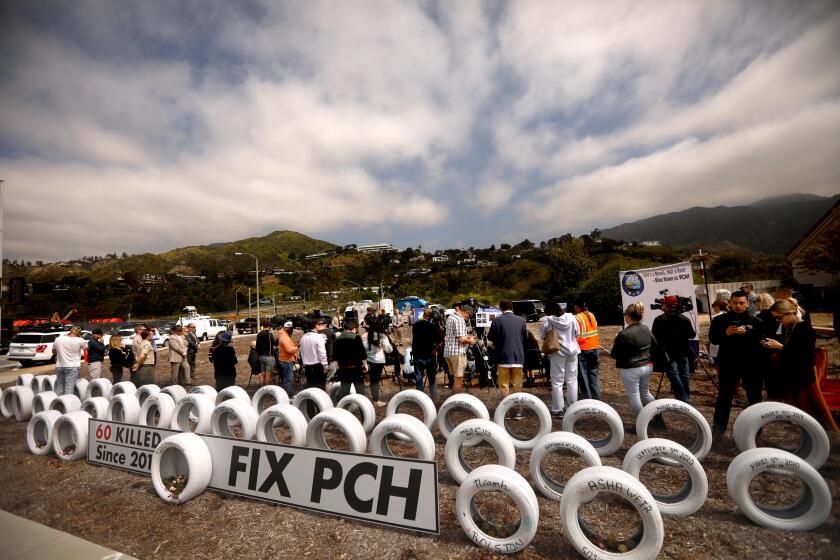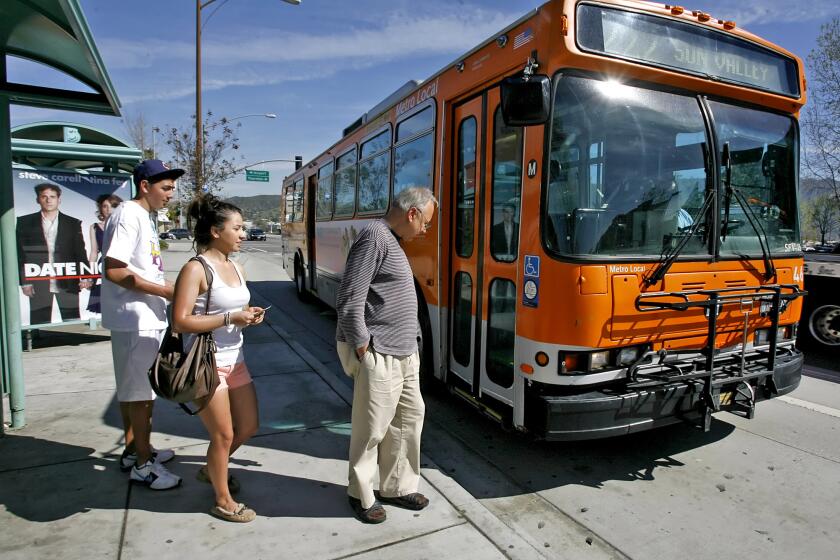Playa Vista Developer May Escape Traffic Fees : Transportation: The builder may be allowed to satisfy a city law by constructing roads and low-income housing, and designing transit plans.
A fund designed to make developers pay for transportation improvements in the crowded corridor between Santa Monica and El Segundo may not receive a penny from the largest builder in the region, according to city officials.
Maguire Thomas Partners, which plans to build a mini-city called Playa Vista between Marina del Rey and the Westchester bluffs, may be freed from up to $68.3 million in fees it faced under a city transportation law, officials in the Los Angeles city Department of Transportation say.
The builder instead could meet its obligations under the law by building roads itself, designing transit plans to keep drivers off the streets and constructing low-income housing.
The final form of the Coastal Transportation Corridor Specific Plan, the ordinance that will outline responsibilities for Maguire Thomas and other builders in the Santa Monica-El Segundo corridor, is expected to be amended by the Los Angeles City Council within a month. The council initially approved the plan in 1985, but is rewriting it because the law has raised only a fraction of what was predicted for transportation work.
The debate over rewriting the law has continued for several months--frequently pitting Department of Transportation officials against Westside Councilwoman Ruth Galanter and Maguire Thomas representatives. Galanter and her staff have supported larger incentives for developers to build roads themselves, design transit plans and construct low-income housing, while the transportation engineers have endorsed smaller incentives to ensure that money is paid into the transportation fund.
At stake is how developers will be held accountable for the traffic their projects put on the streets.
S. E. Rowe, general manager of the Department of Transportation, wrote in a recent memo that alternatives supported by Galanter would reduce the transit fund and “could seriously jeopardize the ability of the (Coastal Transportation Corridor) Specific Plan to effectively produce the needed transportation improvements.”
But Galanter calls her attempt to provide incentives to encourage low-income housing a pioneering effort that will reduce traffic by bringing workers closer to their jobs. The councilwoman says that many clerical workers and others who will work in Playa Vista’s offices cannot now afford housing on the Westside but that subsidized apartments in the project may allow them to live close to their jobs.
Galanter concedes that there “is not a lot of evidence” on how some of her proposals would reduce traffic. “But we know the old approaches don’t work” in terms of lessening traffic congestion, she said.
The rest of the City Council is expected to weigh Galanter’s viewpoint heavily, since the Coastal Transportation Corridor is entirely within her 6th District.
Nelson C. Rising, a senior partner at Maguire Thomas, backs most of the plan amendments pushed by Galanter, saying they would encourage his firm to build far more in transportation improvements than the city would receive simply by collecting money in a fund for future traffic-related projects.
Rising said his firm’s work will include adding lanes to major thoroughfares, such as Lincoln, Jefferson and Culver boulevards; building an east-west road as an alternative to Jefferson and a north-south road to relieve some of the traffic on Lincoln, and extending Admiralty Way to Culver Boulevard.
Private companies will make road improvements more quickly and efficiently than government, Rising argues.
“The Department of Transportation’s view is that they want money paid into a fund,” Rising said. “We want to spend the money (ourselves) in the most effective way. Either way, we pay the money.”
The basics of the new ordinance appear set:
Builders would have to pay $5,690 for every car expected to come to or from their commercial projects during the average peak afternoon commute hour. The money would be deposited in a fund that ultimately would pay new construction between Santa Monica and El Segundo and east to the San Diego Freeway. The projects would include new roads, bridges, traffic signals and other improvements.
As the largest developer in the area, Maguire Thomas has been expected to contribute heavily to the transportation fund. Playa Vista is proposed to include 11,750 residential units, 5 million square feet of offices, 720,000 square feet of retail space, 2,400 hotel rooms and a marina on 670 acres. It will produce about 20,000 automobile trips during a typical peak afternoon commuting hour, transportation officials say.
Since residential construction is not subject to the fees, Maguire Thomas would be liable for 12,000 of those trips, or about $68.3 million in transportation fees.
But under the revised law headed to the City Council, Maguire Thomas could wipe out its entire $68.3 million obligation. Instead, the company would commit to spending up to $60 million for building roads itself and receive two substantial credits--up to $20 million for building low-income housing and up to $17 million for instituting a traffic reduction program for employees who will work at Playa Vista.
Each of those items has been the subject of intense debate.
The various interests struggled to reach agreement, for instance, on how much Maguire Thomas and other builders should be able to reduce their traffic fees by building their own roads.
Department of Transportation officials initially argued that builders should get credit, and reduce the fees they must pay, only if they build projects from a list that transportation officials say is needed for the area. But Maguire Thomas officials, backed by Galanter, argued that developers should be given credit for other large roadways they build that are not on the list.
Recently, transportation officials and Galanter’s office agreed to a compromise that will credit developers for any portion of roads they build that are deemed to serve the entire region.
But even that agreement is not likely to end the debate.
Maguire Thomas’ Rising has said, for instance, that he expects the firm to get credit for at least $60 million in traffic improvements.
But transportation officials say privately that they think closer study will show that many of the company’s new roads primarily will serve the mini-city of Playa Vista. One predicted that Maguire Thomas would receive credit for substantially less than $60 million in new roads, saying: “I think $60 million is way out of line.”
The idea of reducing traffic fees in return for building low-income housing has also caused dissension.
Galanter proposed the idea, saying builders need more financial incentives to build affordable housing on the Westside. A proposal that she backs, to be considered by the City Council, would reduce developers’ transportation fees by $11,380 for each unit of low-income housing they build.
With a proposed 1,760 affordable apartments in its plans, that would save Maguire Thomas more than $20 million in traffic fees.
Galanter argues that the Westside’s basic traffic problem--jobs are too distant from housing--won’t be solved until more affordable homes are built.
Transportation officials say that the proximity of housing will reduce some traffic, but much less than Galanter is hoping for. The low-income housing bonus they support would reduce Maguire Thomas’ traffic fees by just $7 million.
The final area of dispute has been how much credit developers should get for designing transit plans to keep cars off the road.
Galanter has suggested that builders should be able to cut their traffic fees by up to 25% if they can design a transit plan that puts an average of 1.5 drivers in each car. That could mean a reduction of $17 million in fees for Playa Vista. The Department of Transportation has favored a 20% credit that would cut Playa Vista’s fee by just $13.6 million.
And the two sides have also squabbled about when the fees should be paid.
Transportation planners want the money before projects are built, only to return it if car-pooling, mass transit and other programs reduce traffic as much as developers predict.
Galanter, in contrast, supports a plan that would allow builders to pay their fees later if their transit plans prove unsuccessful. If the developers did not pay their fees, the final phases of large projects could be prohibited.
The councilwoman won out in council committee debates, and her positions will be included in the draft ordinance to be considered by the full council.
More to Read
Start your day right
Sign up for Essential California for news, features and recommendations from the L.A. Times and beyond in your inbox six days a week.
You may occasionally receive promotional content from the Los Angeles Times.







